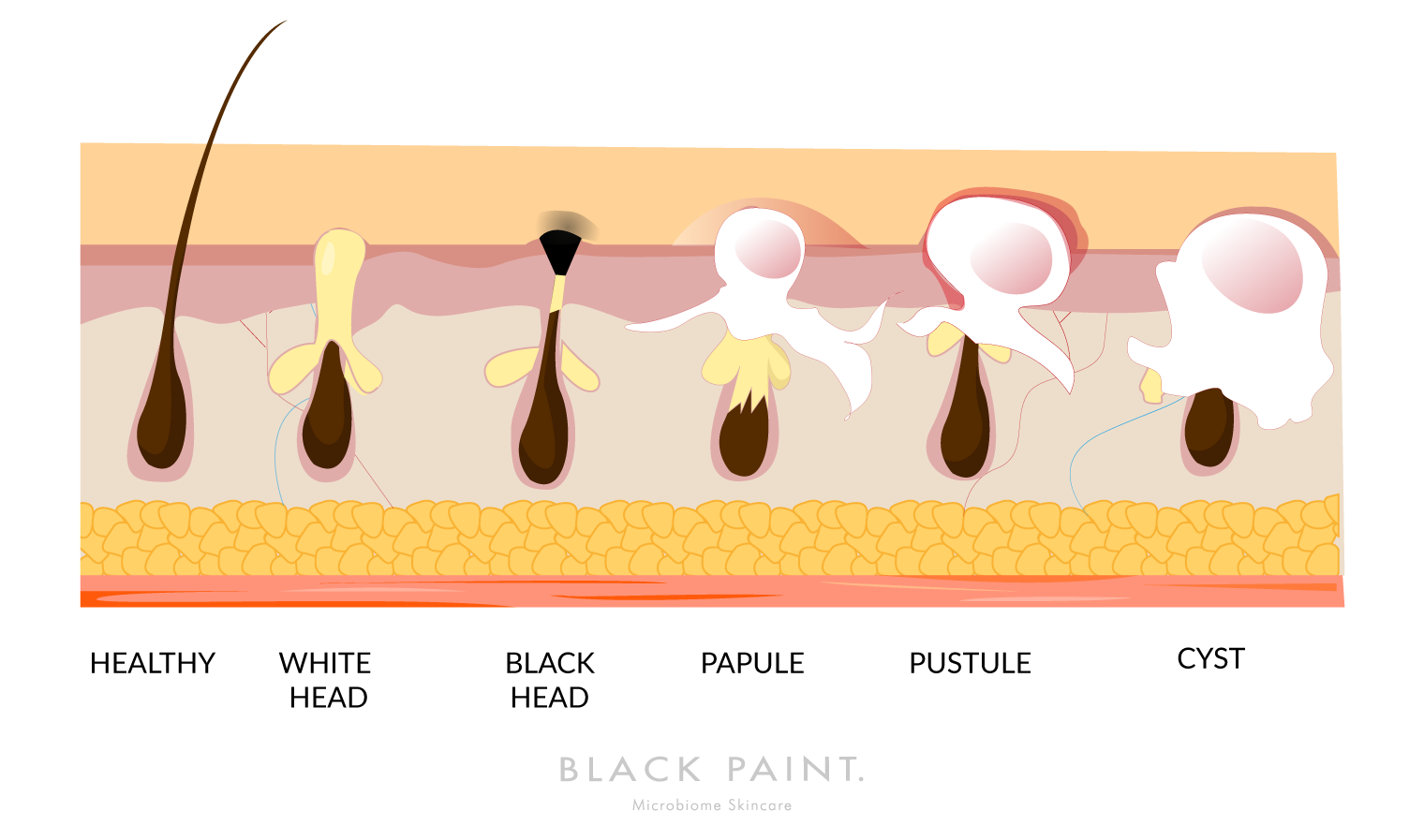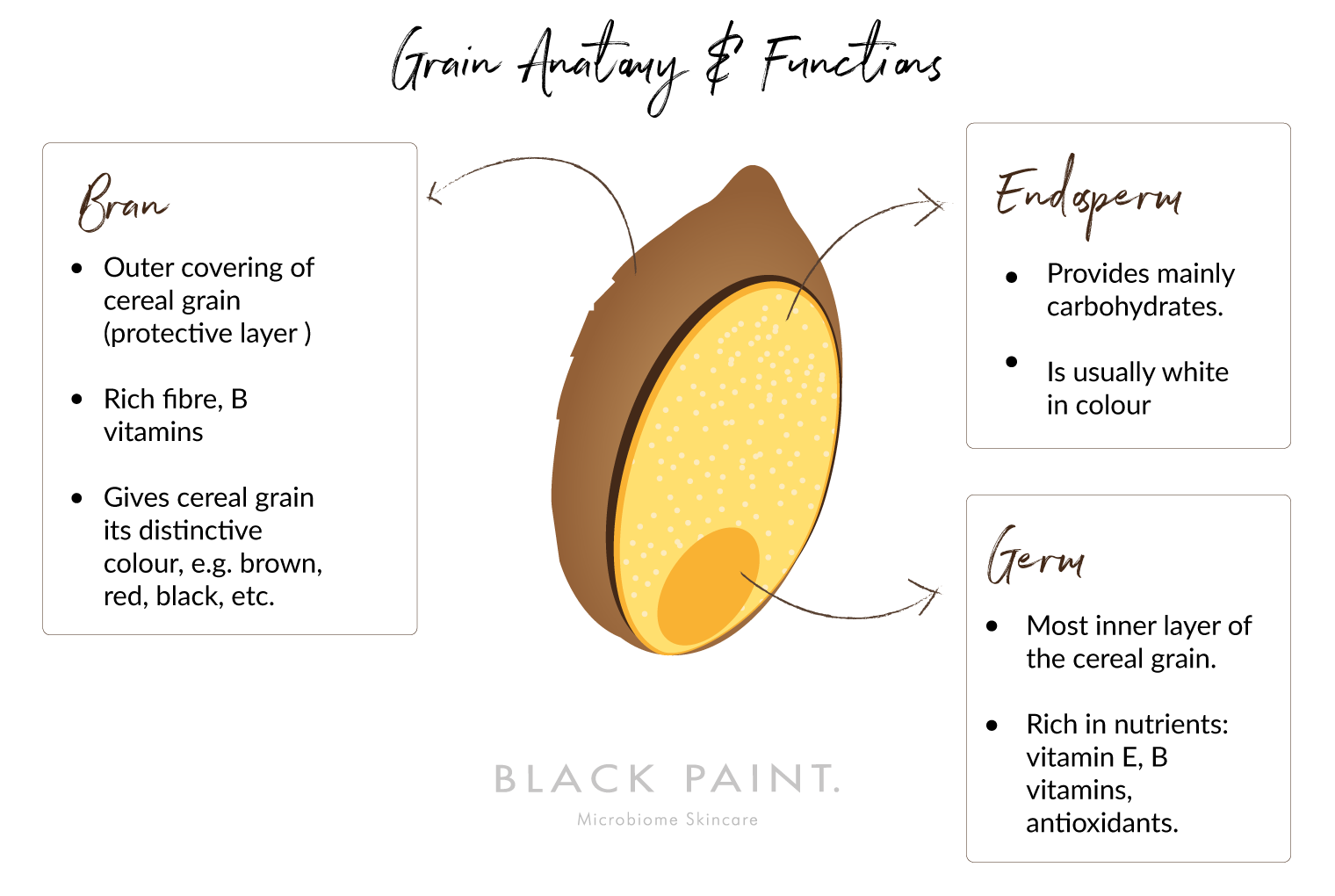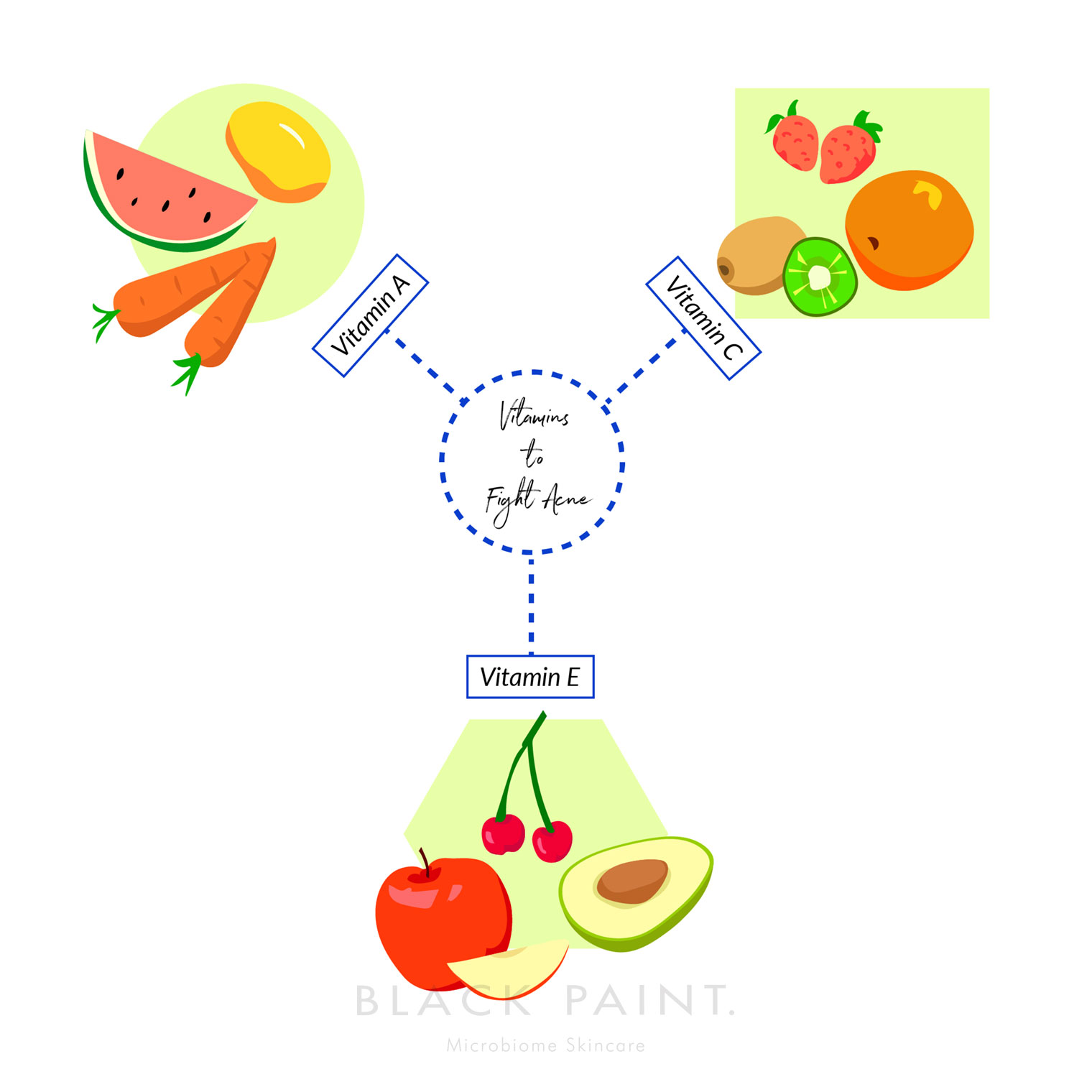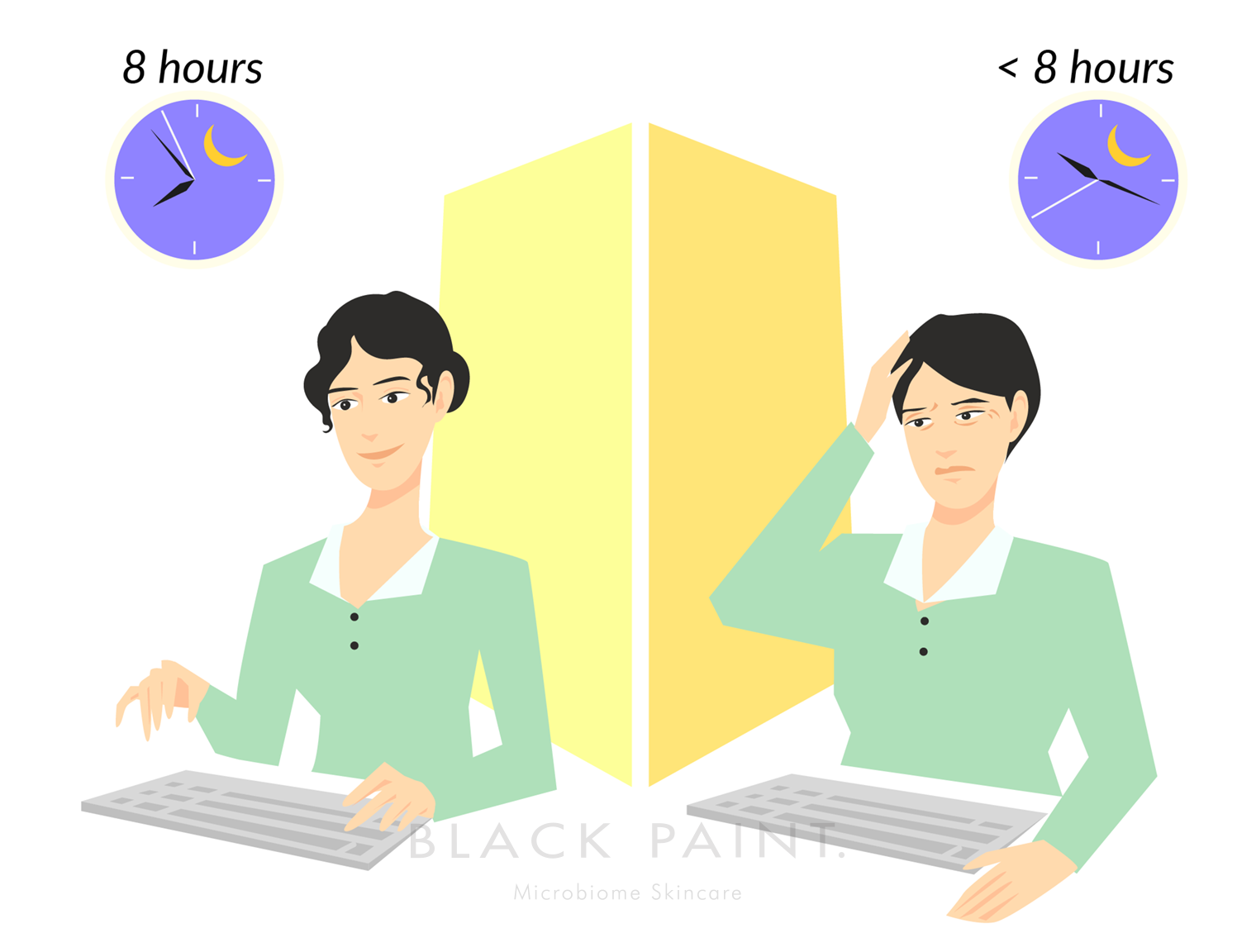It’s easy to blame skincare products, polluted environment, stress for your never-ending acne breakouts, but did you know, your diet could also play a role? As the saying goes – You are what you eat.
Why do we get acne?
Acne is one of the most common skin problems commonly experienced by teenagers and young adults. However, anyone, at any age, can get acne. Acne also does not discriminate between gender – meaning, both men and women can get acne.
Just beneath the skin lies thousands of oil glands (sebaceous glands), and their main function is to produce sebum (oil) to prevent skin from drying out. These sebaceous glands are attached to hair follicles, which are small holes in the skin where hair grows out. Usually, the production of sebum decreases as we age. That is why as we grow older, we need more rich skincare products (think face creams, facial oil) to moisturise the skin.
When these sebaceous glands produce too much sebum, it causes hair follicles/pores to become clogged with oil. Normal dead skin cells usually rise to the surface of the skin and are removed by the body. However, when excessive oil (sebum) is produced, the dead skin cells clump together and become trapped inside the pore.
If the trapped pore is close to the skin’s surface, it will bulge outwards, forming a white head. A blackhead forms when the trapped follicle is open to the skin. Sometimes trapped pores become infected by bacteria living on our skin. This (entry of bacteria into oil-clogged pore) infects and inflames pores (becoming red and swollen). If the infection goes deep into the skin, an acne cyst or nodule results.

Causes of acne
The usual culprits for acne are:
Hormones
This is why acne usually affects teenagers and young adults.
Some women also report experiencing an acne breakout close to or around their periods, and that’s because of the hormones estrogen, progesterone and testosterone at play.
- Estrogen is the main hormone in the first half of the menstrual cycle, but in the second half of the menstrual cycle, progesterone becomes the predominant hormone.
- Testosterone levels remain fairly stable throughout the whole month, although its level rises closer to the start of and during the menstrual cycle.
These shifts in hormone levels during the menstrual cycle can affect the woman’s skin.
For one, sebum production increases mid-way through the menstrual cycle as progesterone level rises. During this period, skin swells but pores in skin remain closed, causing a layer of sebum to build up underneath the skin. Adding onto this is the effect of the rising levels of testosterone, which stimulate the oil glands to produce more sebum. The oil (sebum) produced on skin becomes food for bacteria (P. acnes bacterium). It is this bacterium that causes increased breakouts and inflammation which some women can relate to nearing their menstrual periods or during their periods.
Eating a poor quality diet
Which brings us to the next point in this article…
The relationship between food, blood sugar levels, and insulin
Food provides us with various nutrients, including carbohydrates. Carbohydrates are one of the three main macronutrients the body needs, the others being protein and fat. They are termed “macronutrients” because the body needs them in large amounts. Apart from providing the body with calories (i.e. energy), each macronutrient also has its own function(s), e.g. protein is needed for building and repairing muscles, unrefined carbohydrates supply the body with fibre, vitamins and minerals (a point which will be explained later in this article).
Between carbohydrates and insulin
When we eat carbohydrates (like rice, noodles, bread, table sugar, honey), it goes to the stomach and breaks down into smaller molecules called glucose. Glucose then enters the bloodstream, causing blood glucose levels (aka blood sugar levels) to rise. There is this organ called the pancreas in the body, which produces the hormone, insulin, needed to bring blood glucose levels back to normal after a meal. How much insulin is produced and secreted corresponds to the amount of glucose in the bloodstream.
Between insulin and glucose
Insulin’s main job is to bring the body’s blood glucose level back to normal after a meal, and how it (insulin) does this is by facilitating the entry of glucose into the body cells. I’d like to use the lock-and-key mechanism to explain this. Think of insulin as the key which is needed to open the doors on body cells to allow glucose to enter. This movement of glucose (into body cells) is vital to not only bring the blood glucose levels back to normal post-meal but is also important for proper body functions.
Glucose is the main source of fuel for the muscles and brain. If our muscles don’t get glucose, we feel weak. Likewise, if the brain doesn’t get glucose, our thinking and concentration levels plummet. Which is why when someone cuts carbohydrates out of their diet, they find that they can’t concentrate well at work, and/or are constantly feeling very grouchy.
What happens when insulin (the key) is missing? Glucose can’t enter body cells, so blood glucose (blood sugar) level remains constantly high. This is what happens in diabetes.
Three types of diabetes
Type 1 diabetes
The body produces minimal or no insulin at all. Type 1 diabetes happens when the body cells turn on itself, i.e. body cells attack the cells in the pancreas which make insulin. And so, the pancreas loses the ability to produce insulin.
This (type 1 diabetes) has nothing to do with diet or lifestyle and usually happens to children and young adults. Individuals with type 1 diabetes usually need to have insulin injections for life.
Type 2 diabetes
This is the one which most of us are all too familiar with. Main causes (for type 2 diabetes) are family history, aging, leading sedentary lifestyles, and obesity.
The main cause for type 2 diabetes is insulin resistance – i.e. the body cells become insensitive to the actions of insulin, so glucose can’t enter body cells, thus blood glucose levels continue to remain high after a meal.
Gestational diabetes
As the term says, this diabetes is only seen in pregnant women. So a woman who’s never had diabetes before develops diabetes during pregnancy. These ladies would need to ensure they develop good lifestyle habits post-pregnancy as they have a higher risk of developing type 2 diabetes later on in life if good lifestyle practices are not adopted.
How different carbohydrates affect blood glucose and insulin levels
As mentioned earlier, carbohydrate is the main nutrient which affects blood sugar level. How fast blood sugar rises depends on the type of carbohydrates eaten. But first, let me explain the anatomy of a cereal grain:

After having understood the various parts of the cereal grain, let us now understand the differences between the two main types of carbohydrates:
HIGH glycaemic index (High GI) carbohydrates & LOW glycaemic index (Low GI) carbohydrates.
What happens in our body when we eat them?
High GI carbohydrates
- Quicker digestion – due to loss of fibre as bran is stripped off during processing.
- The germ is also removed during processing.
- So blood sugar level rises up very quickly.
- Quicker release of insulin into the bloodstream to bring blood sugar level back to normal.
Low GI carbohydrates
- Digested slower – basically the whole cereal grain does not undergo any processing at all.
- So blood sugar level rises slowly.
- Thus, the slow release of insulin into the bloodstream.
How would you feel then?
High GI carbohydrates
- That energy slump we are familiar with after eating a meal that is rich in this type of carbs.
- So making you reach for that candy/chocolate bar to give you that burst of energy again => it’s not called “sugar rush” for nothing.
Low GI carbohydrates
- Energized all day – why? Because blood sugar level remains constant.
- Reduced tendency to snack too!
Food Examples
High GI carbohydrates
- White bread, white rice, white flour, etc.
- Table sugar (sugar), jams, marmalade, honey, maple syrups.
- Anything made with white flour, e.g. biscuits, pastries, cakes.
- Fruit juice (contains minimal fibre).
- Regular soft drinks, cordials.
Low GI carbohydrates
- Brown rice, red rice, black rice.
- Wholemeal noodles/pasta.
- Healthy grains like quinoa, barley.
- Beans & legumes.
- Whole fruit.
- Starchy vegetables with skin on, e.g. potatoes, yam.
- Wholegrain/multigrain bread.
(Note: not all brown bread are low GI. Ensure brown colour is due to the addition of wholegrains, instead of brown syrup like molasses. Check the ingredient list if unsure).
What does this mean?
- High GI Carbohydrates: consume LESS OFTEN.
- Low GI Carbohydrates: consume MORE OFTEN.
With the relationship between diet and insulin responses in mind, we now understand why low GI carbs are a better option. Let us look at how low GI diet can help if you suffer from acne.
As explained earlier in this article, changes in hormone levels can lead to an acne outbreak. And we already know eating too much of high GI carbs can lead to an insulin spike in our body.
It is found that too much insulin in the blood (“hyperinsulinaemia”) may lead to an increased production of androgens (male hormones, e.g. testosterone). Thus, this aggravates acne further through various processes. These can include disturbing the normal shredding of follicular corneocytes, increasing androgen-mediated sebum production, and allowing the bacteria, Propionibacterium acnes, to colonise in comedones (blackheads), thus triggering/worsening inflammation of these blackheads. Corneocytes are keratinocytes which have reached the end of their lifecycle and comprise mainly of cells of the stratum corneum (outer epidermis of the skin). It was found when people with acne were put on a low GI diet, their acne symptoms improve. For this reason, dermatologists advise their patients to adopt a low GI diet, in conjunction with medical treatments. This helps to improve/manage acne symptoms.
Practical tips for adopting a low GI diet
- Swap brown rice for white rice, wholegrain or multigrain bread instead of white bread.
- If you find switching to brown rice hard to chew/unpalatable at first, try beginning with mixed brown rice to get used to the taste and texture. E.g. Replace 20% of white rice with brown rice, and slowly increase the brown rice proportion and reduce the white rice proportion. Continue until you come to a time when your taste buds can accept 100% brown rice.
- If you are a cereal person: choose steel cut oats or muesli over granola and regular cornflakes. Granolas may seem healthy, but they are usually coated with oil and sweeteners like honey/brown sugar/cane sugar (syrup). They are also puffed/toasted to give that crunchy bite and golden brown colour. Hence, I would advise swapping granolas to their healthier cousin, muesli, or to make granolas an occasional treat.
- Try eating apples/pears with skin on – skin is rich in fibre, and not to mention antioxidants! Make sure you wash the skin thoroughly before eating!
Basically, the more fibre you have in your diet, the more slowly foods are digested. Thus, resulting in better blood sugar control and more consistent levels of insulin in the blood.
Other perks of adopting a low GI diet
- Weight management. For those who are looking to lose/maintain your weight, a low GI diet can help by keeping you full longer. This reduces (or even eliminates) the need to snack/give in to cravings.
- More energy throughout the day. This is due to the slow release of glucose into the bloodstream, giving constant blood sugar level throughout the day.
Other tips for managing acne
Include more vitamin-rich foods in your diet
Vitamin A
We all know vitamin A is good for our eyes, but did you know of its importance in skin health? Yup, you heard me right! Besides being involved in vision health (especially night vision), its other roles include supporting immune function and proper growth and differentiation of cells. In particular, it supports cells involved in mucus production) and tissues. These include those lining the skin, respiratory tract (lungs), heart, digestive tract, and kidneys.
Mucus is an essential lubricant in the body and also has a protective function as well – think about it. If we didn’t have mucus lining the stomach, the stomach wall would have been worn thin due to the corrosive action of the digestive juice, which primarily consists of hydrochloric acid! Now in terms of skin health, what happens then if there is a deficiency in vitamin A in the body? Skin becomes dry, feels rough and the healing process is impaired, i.e. slow healing of wounds post-acne.
Vitamin C
Vitamin C is a vitamin which needs no introduction. We know it is important for good immune function and skin health. This includes good wound healing, making connective tissues and collagen, and providing antioxidant protection.
As an antioxidant, it helps neutralise the damaging effects of free radicals, which are generated when we expose the body/skin to environmental pollutants. This prevents/protects the body against collagen breakdown. That is why vitamin C is commonly found in many skincare products (especially anti-aging ones) or health supplements.
Vitamin E
Like vitamin C, vitamin E also has antioxidant properties, i.e. prevents/neutralises the damaging effects of free radicals, hence the importance of including this vitamin in your daily diet.
What foods are rich in vitamins A, C and E?
VITAMIN A
There are two main forms of vitamin A – preformed vitamin A and provitamin A and preformed vitamin A.
- Provitamin vitamin A:
An inactive form of vitamin A, meaning the body would need to convert it to an active form before it can be used for its various purposes. In more layman terms, provitamin vitamin A equals beta-carotene, and is the ‘orangey’ pigment found in orange colour fruits and vegetables, like pumpkin, carrots, papaya and rockmelon (cantaloupe). - Preformed vitamin A:
An active form of vitamin A, meaning it is ready for use by the body upon ingestion. Preformed vitamin A is sometimes referred to as retinoids.
Fish oils/cod liver oil and liver contain the most preformed vitamin A, although other good food sources of preformed vitamin A include fortified milk and egg yolks.
VITAMIN C
Fruits and vegetables are the best food sources of vitamin C. Examples of good food sources of vitamin C include citrus fruits (orange, grapefruits), berries, kiwi, melon (especially cantaloupe/rock melon), broccoli, and Brussel sprouts.
One thing to note though, vitamin C levels in food may drop during prolonged storage and after cooking as it is a water-soluble and heat-sensitive vitamin. Best way to get vitamin C is to eat them raw. But for those of us who don’t like the raw taste of vegetables (especially), steaming or microwaving the vegetables are the best ways to preserve as much vitamin C as possible.
VITAMIN E
Nuts (e.g. almonds, peanuts), seeds (e.g. sunflower seeds), and plant oils (like peanut, corn, wheatgerm oil) are rich in vitamin E. Wholegrains are also rich in vitamin E as the germ (see diagram of cereal grain above) remains even during processing, so this is another reason for including wholegrains (like brown rice, oatmeal) into your diet.

Eat more oily fish (hello salmon!)
Oily fish are rich in omega-3 fatty acids, which most of us know is good for cardiovascular health due to anti-inflammatory property and ability to lower cholesterol. Additionally, omega-3 fatty acid is also important for good skin. Our body can’t make these “essential” fatty acids; hence it is important we include them in our daily diet.
Omega-3 fatty acids are an important structural component of cell membranes and for balancing the oil-to-water ratio in the skin. Since our skin consists of numerous (skin) cells, hence ensuring adequate intake of omega-3 fatty acid keeps cell membranes healthy, giving rise to soft and supple skin, balanced oil production, and good healing of acne scars.
Good food sources of omega-3 fatty acids include oily fish (salmon, cod, sardines), nuts (like walnuts), seeds [e.g. chia seeds, linseeds (aka flaxseeds)], and plant oils like canola, soya bean and linseed/flaxseed oils.
Lifestyle
Manage stress
When you are under stress, your body goes into defensive mode, so what that means is, your body reacts by producing “fight-or-flight” hormones, such as cortisol and adrenaline, which not only leads to familiar effects like increased heart rate, but these hormones can also lead to increased blood sugar levels (makes your body break down stored glucose in the form of glycogen, and release glucose into the bloodstream) in preparation to fight the stress stimulus. This happens as a result of evolution. Not forgetting, there are some of us who are prone to stress-eating, meaning reaching for that candy bar/bar of chocolate under stress. This can lead to further increase in blood sugar level.
In reaction to increased blood sugar level, body releases (more) insulin to counter that rise in blood sugar level. Over time, a constant stress response causes the body to become less sensitive to insulin. Because of this, the body would need to produce more insulin to counter that resistance.
As mentioned earlier, too much insulin circulating in the bloodstream can lead to increased androgen production. This is why some people experience acne breakout when they are under stressful periods.
One way to counter this would be to find ways to manage this stress. Some tips include prioritising workload, doing exercise (a very good stress buster, and can help in improving mood via the release of endorphins, the “feel-good hormones”), or talking things out with your family/friends.
Ensure you are getting sufficient sleep
Your body needs about 7-8 hours of sleep in order to function at its best, and anything less that way turns our life and health upside down. The body repairs itself and recovers while you sleep; hence it is important to ensure you get that quality sleep.
Effects of insufficient sleep
- You age faster:
Because of the decline in collagen production, wrinkles appear and skin looks less plump. - Pale complexion:
Sufficient sleep ensures good blood circulating around the body, including blood flowing to your face. With inadequate sleep, poor blood circulation results, making you look tired, pale (dull) and lifeless. - Greater waistline:
Not getting enough sleep may lead to an increased circulating level of ghrelin (the hormone which triggers hunger) and lower levels of leptin (a hormone that signals “fullness”) in the body. So what that means is, less sleep makes you feel hungry more easily (i.e. increased appetite). Plus, energy expenditure also drops when you sleep less. Combining these two factors equals increased waistline and overall body weight - Blood sugar level goes out of whack:
Lack of sleep may also lead to lowered glucose tolerance (i.e. increased insulin resistance), which in the long run, increases the risk of diabetes. The body also releases more stress hormones (cortisol) when you sleep less. And as mentioned earlier, cortisol may increase your fasting blood sugar level to cope with that “stress” from the lack of sleep.

With a better understanding of the downsides of insufficient sleep, you see why medical professionals place emphasis on it. It’s not only for vanity sake. See below for some useful tips to help you get a good night’s sleep!
Tips for a better night
- Have a regular sleep pattern: i.e. go to bed and rise at the same time every day, even on weekends. This is important to help your body develop a regular sleep-wake pattern.
- Avoid stimulants (i.e. caffeine in tea, coffee, even chocolate, and vigorous exercises) close to bedtime.
- Have your last meal at least 2-3 hours before your bedtime. Avoid having spicy, fatty/oily foods, and citrus foods for dinner as these are hard to digest and may cause stomach discomfort just before bedtime.
- If you can’t go to bed hungry, have something light, like a small warm glass of milk, before going to sleep.
- As tempting as it sounds, no alcohol before bedtime. Yes, it makes you sleepy, but you’ll end up having disrupted sleep due to frequent trips to the toilet during the night.
- Likewise, avoid drinking too much water close to bedtime.
- Ensure your room is dark.
- Avoid watching TV, tablets, or looking at your mobile phones just before going to bed. The blue light emitted from these devices can disrupt the body’s ability to produce melatonin, sleep hormone.
- Try adding a few drops of calming aromatherapy oils like lavender or ylang-ylang, to your bedtime bath or sleeping pillow.
In conclusion…
Acne is a skin condition that grapples both teens and adults and is largely a hormonal issue. Although this involves puberty hormones, sometimes poor diets can be a result of it, especially if the diet consists primarily of processed foods which are high in refined sugar.
Besides paying attention to diet quality, if you suffer from acne, you should also be mindful of other lifestyle habits/practices that may cause an acne outbreak such as leading a stressful lifestyle or lack of sleep. If they are contributing (to the acne outbreak), then measures to manage these are important, not just for managing the acne, but also for the sake of your mental, emotional and physical health.
References
https://www.aad.org/public/diseases/acne-and-rosacea/acne#overview
http://thedevonshireclinic.co.uk/wp-content/uploads/2016/04/London-Dermatology-Acne-Scarring.jpg
https://www.webmd.com/skin-problems-and-treatments/acne/features/period#1. Accessed 12 July 2018
http://www.bakeridi.edu.au
https://doi.org/10.1093/ajcn/86.1.107
https://medical-dictionary.thefreedictionary.com/corneocyte
https://www.acne.org.au/low-gi-diet-best-evidence-for-improving-acne
https://ods.od.nih.gov/factsheets/VitaminA-HealthProfessional/#h3
https://ods.od.nih.gov/factsheets/VitaminC-HealthProfessional/#h3
https://ods.od.nih.gov/factsheets/VitaminE-HealthProfessional/
https://www.medicalnewstoday.com/articles/40253.php
https://www.webmd.com/beauty/features/beauty-sleep#1
https://doi.org/10.1186/s12889-018-5557-8
http://www.dailymail.co.uk/health/article-51130/A-good-sleep-make-look-younger.html







